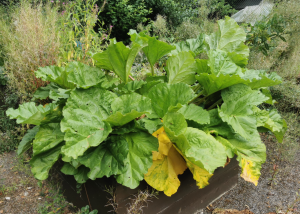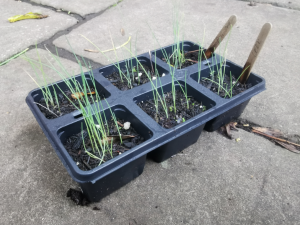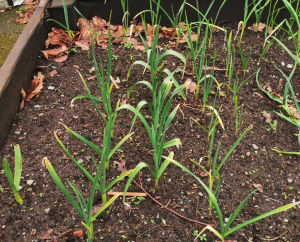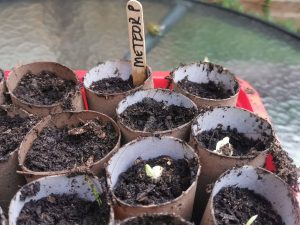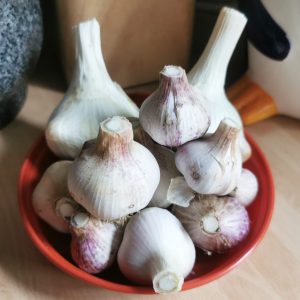
Winter is traditionally the time that onions and garlic are started, but there are also lots of other food crops that can be started now, some for an early spring harvest, and some for next winter!
This article covers the months of November, December and January.
What Can You Sow Now?
The typical seasons are all over the place which is in part due to climate change. If a seed packet says something should be sown in September, you can probably get away with sowing them in October too. I sowed leek seeds in Sept but I should’ve waited until November, but they’re growing fine!
October and November:
Seeds that can be started in October and up to mid-November include:
- Lettuce – Winter Density
- Cabbage – Caraflex F1. Grow this under cover or indoors to start with
- Spring Onion – White Lisbon, winter hardy. Make sure you use the winter hardy variety!
- Cauliflower – All The Year Round. Start these indoors or under cover, and plant them out in March/April
- Broad Bean
- Peas – Meteor and Douce Provence
- Corn Salad (Lambs Lettuce)
All of these can be started in a mini greenhouse, a proper greenhouse or polytunnel, with little plastic bag houses over the pots, or on a windowsill. You could also use plastic fruit punnets as lids to act as a mini greenhouse! The lettuce and corn salad should be direct sown (sow the seed where you want the crop to grow) and protected from birds.
November:
New crops that can be started from seed in November are Leeks – Blue Solaise. Sow lots of seeds to a pot, leave them to grow, and then prick them out when they are big enough.
You can also plant bare root fruit canes of raspberries, blackberries, gooseberries and currants. For a permanent crop, rhubarb crowns can also be planted now. Give rhubarb lots of room to sprawl – they need a minimum of one metre between crowns!
December:
December is traditionally the time that garlic and onions are planted – normally on the shortest day of the year. I start mine much earlier in October to give them a longer growing period.
January:
January has lots of seeds to choose from! Start all of these seeds in pots indoors or under cover (cloche, greenhouse, plastic bag):
- Leek – ‘Giant Winter’
- Aubergine – ‘Long Purple’
- Tomato – ‘Shirley F1’
- Turnip
- Some types of carrot can be sown in January – ‘Amsterdam Forcing 3’ is one type. Direct sow these with some frost protection over the top
Seed Spacing
Seeds are best started in pots at this time of year. Leeks can have up to ten seeds per 10cm pot, and turnip, tomato and aubergine can have up to five seeds per pot.
Onion sets need to be placed with enough room between them for the onion bulb to swell and grow. Aim for a minimum of 10cm between each onion. Onion seeds are started in February, so these are covered in a different article.
Garlic varieties come in all shapes and sizes! The spacing between them varies. Elephant garlic needs up to 20cm between each clove, whereas most other garlic will get away with 10cm spacing. Use garlic bought specifically for planting – shop bought garlic will sprout and can be planted, but it won’t grow particularly well, resulting in small bulbs.
Lettuce and corn salad can be grown indoors if you have room, or direct sown where you want them to grow over winter. Protect the lettuce from birds! Pigeons are fond of lettuce leaves. Sow the lettuce 20-25cm apart, and corn salad 5-10cm apart.
Plant Spacing
Bare root plants will need room to grow, so plant these at least 45cm apart.
Tomatoes and aubergine are best grown in pots. Aim to have one plant per large pot in their final growing positions. You can grow these crops directly in the ground but they need a long warm growing season. Plant them a minimum of 45cm apart. Tomatoes put out a lot of leaves so need room to spread.
Root crops will need room to swell up. This includes carrot, garlic, onions, turnip, and leek. Lettuce, cabbage and cauliflower will also take up a lot of room. Cabbage and cauliflower will need 60cm spacing in each direction!
Time to Sow, Sow, Sow!
Use peat free compost as it is better for the environment and for your plants. Sow seeds, label them (with the sowing date) and put them somewhere protected such as an indoor windowsill, a greenhouse or polytunnel, under a cloche, or use a plastic bag to make individual greenhouses over each separate pot.
Onions, garlic, spring onion, carrot, turnip and leeks can be grown in pots or containers as long as there is enough room or depth for the root to swell. These crops do not need pollinating.
Tomatoes and aubergines are both produced from the flowers, so these crops need pollinating so do best outdoors when they have grown big enough.
I have started my peas (Meteor) in toilet roll tubes, and I will then plant the whole toilet roll into the ground with the pea seeds inside.
Successional Sowing
Successional sowing means not sowing all your seeds at once! Spread them out and sow some now, some in three weeks time, and then more three weeks after that. This means that instead of getting one big harvest period next year, you get a more spread out harvest time and the food crops for longer.
Leek Blue Solaise and Giant Winter can both be sown at three weekly intervals from Nov to Jan (Blue) and Jan to Apr (Giant). Spring onion, carrot and turnip also benefit from being sown regularly to ensure you get a continuous crop next year.
Everything else is best planted at the same time. There are lots of other varieties of tomatoes that can be sown in late spring onwards to give you a continual crop through summer.
Make sure the soil is loose enough for root crops to swell. Carrots go curly or develop extra limbs if the soil is too hard or stoney!
Growing Leeks
Sow the seeds, 10 per pot, and when they are big enough to handle, prick them out into individual pots to grow bigger. When they are the thickness of a pencil, they are ready to be moved into their final growing space, probably round May. They need loose soil in order to swell, so make sure there are no big clods of dirt. Bodge a hole using a stick, about 3-4cm across and place a leek seedling in each hole. Do not back fill the hole. When it rains, or when you water, the dirt will start to fill this hole in. You may need to cover the bed with netting to stop birds pulling the seedlings out of the holes. To get long white stalks on leeks, gently pile up compost around them as they grow. This will block out the light and make the stems white.
Harvest Time and Harvesting
Leek – Blue Solaise will be ready to pull from the November after you planted them, so in this case Nov 2021. They can be left in the ground to overwinter and you only need to pull them up when you’re ready to use them.
Leek – Giant Winter will be ready from October the following year. Loosen the ground gently with a fork but don’t dig them up completely. This makes it easier to dig up leeks when the ground is frozen.
Aubergines should be ready to harvest from July, but it depends when you plant them. Mine are only just starting to flower and at the time of writing it is the end of August, so these will be a very late crop! Cut aubergines off the plant with a sharp knife or secateurs when the fruit is around 10-15cm long, feels firm and is shiny. This aubergine photo was taken in mid-Oct – still a long way to grow!
Tomato – Shirley F1 is a fast cropper so the first harvests can be expected from July. Let the fruits develop to a bright, rich red colour and then gently pull them from the stalk. If they resist the pull, they are not ready.
Garlic and onion are ready to dig up in mid-summer. Wait for the foliage to yellow and die back. Gently remove some of the dirt from around the bulb to check the size. Use a garden fork to get under them to lift the bulbs, and spread them out to dry in the sun either on the floor or on wooden pallets.
Garlic and Onion Flowers
Garlic and onion tend to bolt before harvesting. If this happens, let the flower stalk grow about 15-20cm long (before the flower opens) and then cut it off where it emerges from between the leaves. This is called a scape, and it is edible! Chop it up into small bits and use it as green garlic/onion. Fry it in a pan to start the base for a meal. Click the link in blue to read more.
Crop Rotation
Leek, onion and garlic do not like a lot of nitrogen around their roots so do not plant them after or next to peas and beans.
Tomatoes and aubergines are best grown in individual pots so won’t necessarily follow standard crop rotation. If you plant them directly in the ground, do not plant them next to each other or by potatoes, and do not plant them where you have previously grown potatoes. This can cause a build up of blight in the soil. Aubergines, tomatoes and potatoes are all part of the same family. These are best grown where you have just removed brassicas (cauliflower etc).
Companion Planting
Basil grows well with tomatoes and is said to enhance the flavour. You can grow basil easily from seed, or buy living herbs from the supermarket and pot them into bigger pots. I have grown French marigolds (tagetes) with tomatoes this year and the bed has been full of colour.
From March onwards, you could sow carrot seeds in between rows of the leeks, onions and garlic.
Quantities
Leek can be left in the ground and dug up when you need them, so grow enough to see you through winter. Onions and garlics, when dried, can last for a long time. How many you grow will depend on how often you eat them and how much room you have to store them.
Aubergines and tomatoes do not store well so need to be used fresh. With both crops it is often worth growing lots of plants to get your moneys worth – one aubergine plant may only produce two or three fruits!
Hints and Tips
If you have any questions, Laura is happy to answer them via email, Facebook or Twitter.
- Email: Laura.Hamilton@TCV.org.uk
- Facebook: Health For Life in the Community
- Twitter: TCV_Birmingham
Remember to share your pictures with us on Facebook and Twitter too!
